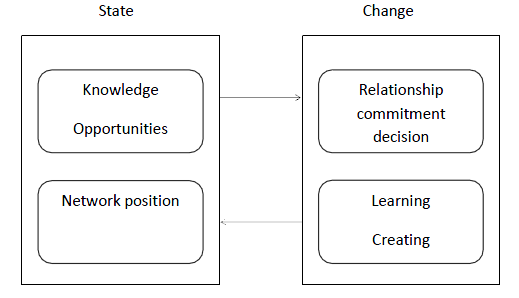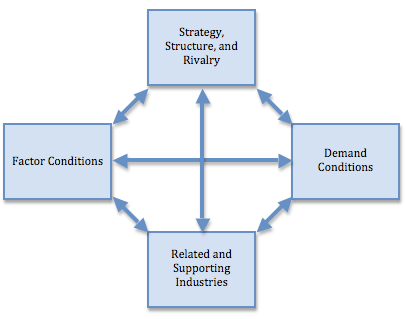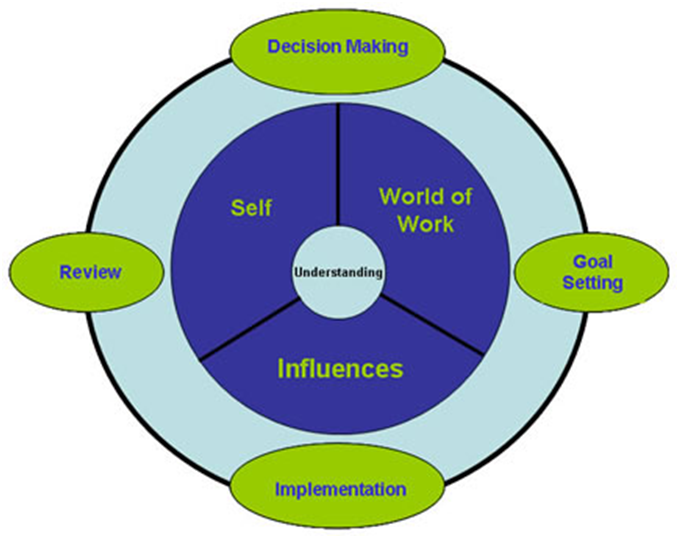
Strategic Theory: Value-Chain Analysis The model of Value-Chain Analysis introduced by Michael Porter (1985) divides business activities into two groups: primary activities and support activities. Primary activities include inbound logistics, operations, outbound logistics, marketing sales, and service and they are related to producing products and services in a direct manner. Support activities, on the other hand, as the name suggests needed to support primary activities of the firm and they consist of firm infrastructure, human resources management, technology development, and procurement. Core benefit of Value-Chain Analysis framework relates to identification and utilisation of opportunities to add more values to certain business processes with positive implications to overall level of competitiveness of the firm. In other words, application of Value-Chain Analysis model provides platform for analysing business processes in an individual manner, so that competitive advantage can be obtained in relation to a specific business process. Moreover, Value-Chain Analysis can be applied to increase the levels of overall strategic competency of the business and strategic competency can be explained as “what in business units does exceptionally well -such as a customer relationship programme, manufacturing, or promotion – that has strategic importance to that business” (Aaker and McLoughlin, 2010, p.7) Inbound logistics relates to a set of activities associated with receiving materials and warehousing and it also includes supply-chain management practices. Operations, on the other hand, relate to the process of transformation of inputs into outputs. Outbound logistics is associated with processing of orders and distribution of products and services. Marketing and sales refers to activities of development and implementation of integrated marketing strategy of the firm. The latest trends in marketing and sales activities can be specified as increasing integration of social media, focus on corporate social responsibility and customer data privacy. Service activities within the framework of Value-Chain Analysis relate to…

This article contains application of Vernon’s Product Life Cycle on the case study of Shanghai Vision Technology Co., Ltd, a medium sized manufacturer of 3D printers and other innovative products based in Shanghai, China. Products of Shanghai Vision Technology to be sold in new markets follow a specific life cycle pattern. This pattern can be effectively explained using Vernon’s product life cycle which comprises four stages: introduction, growth, maturity and decline. Introduction stage for Shanghai Vision Technology 3D printers and other products commences when the product is offered in new market for the first time. During this stage Shanghai Vision Technology products are purchased mainly by ‘innovator’ and ‘early adopter’ consumer categories and the role of effective integrated marketing strategy is paramount. Growth stage for Shanghai Vision Technology products is associated with rapid increase of the sales volume due to the impact of marketing initiatives and word-of mouth marketing. It is important for Shanghai Vision Technology to ensure the supply of its products in the market during this stage. Maturity stage is reached when the majority of Shanghai Vision Technology target customer segment already posses 3D printers and other products offered by the company and its competitors. Maturity stage is associated with market saturation. Decline stage is inevitable for Shanghai Vision Technology products, as well as for products of any other company regardless of the industry and size of the market. Determining the timeframe of this stage in an appropriate manner and introducing new products to the market during the later stages of decline plays an important role for Shanghai Vision Technology in terms of retaining its share in new markets. …

This article contains application of Dunning Eclectic Paradigm on the case study of Shanghai Vision Technology Co., Ltd, a medium sized manufacturer of 3D printers and other innovative products based in Shanghai, China. Exporting can be specified as the most appropriate new market entry strategy for Shanghai Vision Technology during the early stages of internationalisation. Exporting new market entry strategy can be explained a greater depth using Dunning Eclectic Paradigm (DEP) that relies upon three types of advantages – ownership, location and internationalisation advantages. Ownership advantages The choice of exporting as new market entry strategy grants Shanghai Vision Technology the complete ownership advantage of all components of marketing mix. In other words, by choosing exporting the company retains complete freedom in terms of introducing changes to pricing, product specifications, distribution channels and promotion initiatives. Location advantages Ownership and internationalisation advantages to be derived by Shanghai Vision Technology due to the selection of exporting new market entry strategy is going to be facilitated at the expense of location advantages. Specifically, by exporting its products to new markets Shanghai Vision Technology would not possess location advantages with negative implications such as being disadvantaged from tariff barriers and higher transportation costs compared to local businesses. Internationalisation advantages Internationalisation advantages within Dunning Eclectic Paradigm relates to cost advantages that are gained through organising operations within geographical boundaries of new markets. Positive impact of internationalisation to Shanghai Vision Technology is limited during the first stage of international market expansion strategy due to the recommended choice of exporting new market entry strategy. Nevertheless, this specific type of advantage may become available to Shanghai Vision Technology during the later stages of Uppsala model described above once the company establishes sales subsidiaries and production unit abroad.

This article contains application of Uppsala model of internationalisation on the case study of Shanghai Vision Technology Co., Ltd, a medium sized manufacturer of 3D printers and other innovative products based in Shanghai, China. Uppsala model of internationalisation also known as a learning theory of internationalisation identifies four individual steps of internationalisation. According to Uppsala model engaging in exporting in occasional manner should constitute the first step in internationalisation. Initial experience of operating in the new market is going to be gained by Shanghai Vision Technology during this step. Exporting through sales agents in new markets marks the second step in internationalisation. Presence of the company in the new market is going to be increased during this step with positive implications on the levels of knowledge about unique aspects of the market. Establishment of Shanghai Vision Technology sales subsidiaries in foreign market is the third step of internationalisation according to the model. During this step the company is in the position of obtaining experience and knowledge about the market in a direct manner. Starting the production in the foreign market through wholly owned subsidiaries is the last step of internationalisation within the framework of Uppsala model of internationalisation. This step is associated with benefiting from ownership, location and internationalisation advantages by Shanghai Vision Technology to a full extent which is explained with the application of Dunning Electric Paradigm further below. Importantly, Uppsala model acknowledges the lack of knowledge about specifications of new markets to be an important barrier in terms of becoming successful in respective market. In other words, unlike many other models of internationalisation, Uppsala model rightly specifies knowledge about the market as a critical success factors. Revised version of Uppsala model contains the application of basic networking prospect in a way that mutual interactions and influence of state…

This article contains application of Diamond of National Advantage on the case study of Shanghai Vision Technology Co., Ltd, a medium sized manufacturer of 3D printers and other innovative products based in Shanghai, China. Main motive for internationalisation for Shanghai Vision Technology relates to attempts to increase the levels of revenues through international market expansion strategy. The idea of Competitive Advantage of Nations proposed by Porter (1990) is based on four major points of competitive advantage jointly referred to as the Diamond of National Advantage that can be applied to the case study of Shanghai Vision Technology in the following manner: Factor conditions within the framework of the Diamond of National Advantage are favourable towards Shanghai Vision Technology internationalisation perspectives. This is because adequate infrastructure has been developed in China mainly during the last two decades in industry of advanced technologies such as 3D printing to serve as a platform for local manufacturers to compete globally. Demand conditions can also be specified as an important factor that contributes to the level of global competitiveness of Shanghai Vision Technology. In other words, there are not major differences in the nature of demand for 3D printers in home market in China and foreign markets. Therefore, Shanghai Vision Technology’s present successful operation in home market in China can be rightly perceived as a prerequisite for success in the global marketplace to a certain extent. Related and supporting industries in relation to advanced technologies such as 3D printer manufacturing are effectively established in China. Moreover, China is a manufacturing home for a wide range of components of advanced technological products and cost advantage of those components can be specified as an additional point of strengths for Shanghai Vision Technology to compete in a global market. Firm strategy, structure and rivalry is another important point…
By John Dudovskiy
Category: International Business

Employee motivation tools can be divided into two categories: tangible and intangible. Salary and monetary bonuses is the main form of tangible motivation tools, whereas intangible motivation tools include sense of contributing to a great cause, recognition of employee performance by managers in verbal and written ways, celebrations of group and individual achievements etc. Both, tangible and intangible tools of motivation are going to be used in relations with chefs and sales assistant before and during the International Food Event. Tangible motivational tools offered to staff include financial compensation of £8 per hour. A set of intangible motivational tools to be used in this event include verbal encouragement of staff at all stages of the event, explanation of contribution of the event in terms of increasing the levels of cross-cultural awareness, and contributing to good cause as the profit to be made from the sale of food and ingredients are to be donated to the selected charity. Moreover, application of Hertzberg’s Two-Factor Theory (1959) assists in explaining staff and volunteer motivation practices in International Food Event. Two-Factor Theory makes a clear distinction between hygiene factors and motivators. Hygiene factors include salaries, adequate working conditions, appropriate management-employee relationships, acceptable levels of work-life balance etc. Hygiene factors are expected by employees to be in place and their presence may prevent dissatisfaction amongst employees. However, the presence of hygiene factors is not sufficient for employee motivation and employee motivation can only be achieved through the application of motivator factors. Accordingly, motivator factors to be applied in International Food Event include creating challenging, yet rewarding working environment, recognition of contribution of chefs, encouraging the sense of personal achievement due to the participation in the event etc. Alternatively, the issues of motivation at the event can be explained using the framework of Theory X and…

The difference employee recruitment and selection needs to be specified in an appropriate manner. Recruitment can be defined as “the process of confirming the need to employ fresh staff, locating where potential recruits exist and attracting appropriate application for employment” (Akwetey, 2011, p.18). In simple terms, employee recruitment is Recruitment process of staff and volunteers is going to comprise the following five stages: Stage One: Recruitment Planning The first stage in recruitment process relates to identification of skills requirements and clarification of numbers of staff and volunteers needed. Six cuisines – Chinese, Japanese, Italian, Spanish, English and Indian cuisines are going to be represented at the event, and accordingly one chef needs to be employed for each cuisine. There is a vacancy for a member of staff to sell food and ingredients for each cuisine during the event. Moreover, all five group members are going to participate as volunteers and additional volunteers are also welcomed. Stage Two: Identification of Recruitment Sources Generally, recruitment sources can be internal and external (Werner et al., 2012). Internal source of recruitment relates to finding candidates within the company, whereas external source of recruitment relates to recruitment of individuals outside of the organisation. Internal source is going to be explored for recruitment and potential members of staff will be sought amongst second and third year students within the University. Stage Three: Candidate Generation Petition is planned to be launched on Facebook social networking website and applications are going to be attracted from candidates amongst second and third year students studying in University. Dedicated Facebook page is going to explain job specification and candidate requirements for chefs such as cooking experience of at least three years, being passionate about food, possessing advanced communication and interpersonal skills etc. in a detailed manner. Job requirements for…
By John Dudovskiy
Category: HRM

People who plan their career years in advance and make efforts to make them happen achieve far more than those who do not have a long-term plan and make their career decisions dictated only by immediate benefits. It’s better to be proactive for an individual to assess his interests, strengths, weaknesses and realistically evaluate his options and make relevant plans, rather than being reactive and end up in an employment where the individual’s true potentials are not realised for many different reasons. This article illustrates my personal career plan in detail in my chosen field of professional interest – marketing, and lists steps I am planning to undertake to progress to my dream job, anticipating possible challenges, analysing alternative progressions and describing preventive actions. The article also describes career planning methodology, marketing field in general and necessary KSAs to be successful in this field. My personal development plan is provided in the article along with my SMART objectives describing how I am planning to prepare myself for each step which eventually will lead me to my dream job – marketing executive. Dream Job – Marketing Executive Marketing executives promote products, services or ideas by developing marketing strategies and campaigns. They are closely involved in public relations, planning, research, product development, participating in events and organising them. This role is fascinating to me because it provides two job elements which I find exciting: meeting and communicating with people, and seeing the immediate and long-term results of your work. Marketing executives have a wide range of responsibilities and it depends mainly on the sector and the size of the company. The job of a marketing executive includes production of marketing materials, managing the marketing budget, organizing and attending to events, exhibitions etc., evaluating the efficiency of marketing campaigns, conducting market research, and…
By John Dudovskiy
Category: Personal reflection & development

Social security refers to the variety of forms of personal financial assistance to members of society. Being one of the core responsibilities of state, the provision of social security may be granted as a means of dealing with poverty, as a social protection due to financial vulnerability to circumstances, as redistribution tool of income, and as a means of expression of solidarity (Spicker, 2014, online). Major types of social security benefits include social insurance, benefits given to low-income individuals and families, disability benefits, pensions for aged people and discretionary benefits. In UK in particular social security policies are developed and implemented within the scope of Beverage Scheme which is associated with National Insurance accounts for each citizen. Core six principles of Beverage Scheme and National Insurance consist of comprehensiveness, categorisations of insurance, flat nature of benefits and contributions rate, the principle of adequacy and unified administration of National Insurance (Spicker, 2013, online). Additional social policy programs and initiatives aimed at facilitation of social security in UK include, but not limited to Guarantee Credit, Savings Credit, and Child Benefit. Development of social policies in relation to social security of citizens in modern times is associated with a substantial challenge which relates to the recent global economic crisis of 2007 – 2009. In other words, the crisis has necessitated budget reductions in many countries with obvious negative effects on the volume of social security spending, and this result in significant social policy problems. To be more specific, contemporary social policies in relation to social security need to be developed by governments in highly cost-effective manner, and the necessity behind social security reductions need to be communicated to citizens in an effective manner through the application of various communication channels in order to maintain popularity of the government. This task is highly difficult…

Family as a cell of society plays an integral role in facilitation of its functioning in an effective manner. As the most basic unit in society, families can have preventive impact in relation to a wide range of issues such as drug addiction, teenage pregnancy, dealing with stress etc. In other words, neglecting the value of families as the smallest and ancient social institution in society can have highly negative implications for the society at various levels, as well as, having negative effects on the state of national economy in direct and indirect manners. Alternative basic units in society to traditional families include people living alone, single parents, different forms of collective living arrangements, and others. However, the majority of sociologists adopt a skeptical approach about the levels of positive contribution of alternative basic units in society as opposed to traditional families consisting of two parents and one or more children for justified reasons. Escalating role of family as a social structure impose significant challenges to benefits derived from family social institution to the society in the future. A set of factors impacting the decline of popularity of families mainly in developed countries such as UK and USA in a traditional sense with two parents and one or more children include certain demographic tendencies such as ageing population, increasing numbers of couples without children, and household fission i.e. “the tendency for households to split, because of divorce and earlier independence for children” (Spicker, 2014, online). Moreover, a tendency of prioritising career over family amongst young people possesses further threat to the role of families and associated social and personal values in the future. It is important for a state to assume an instrumental role in terms of promoting and reinforcing formation of families in traditional sense in society. This role…
By John Dudovskiy
Category: Politics
